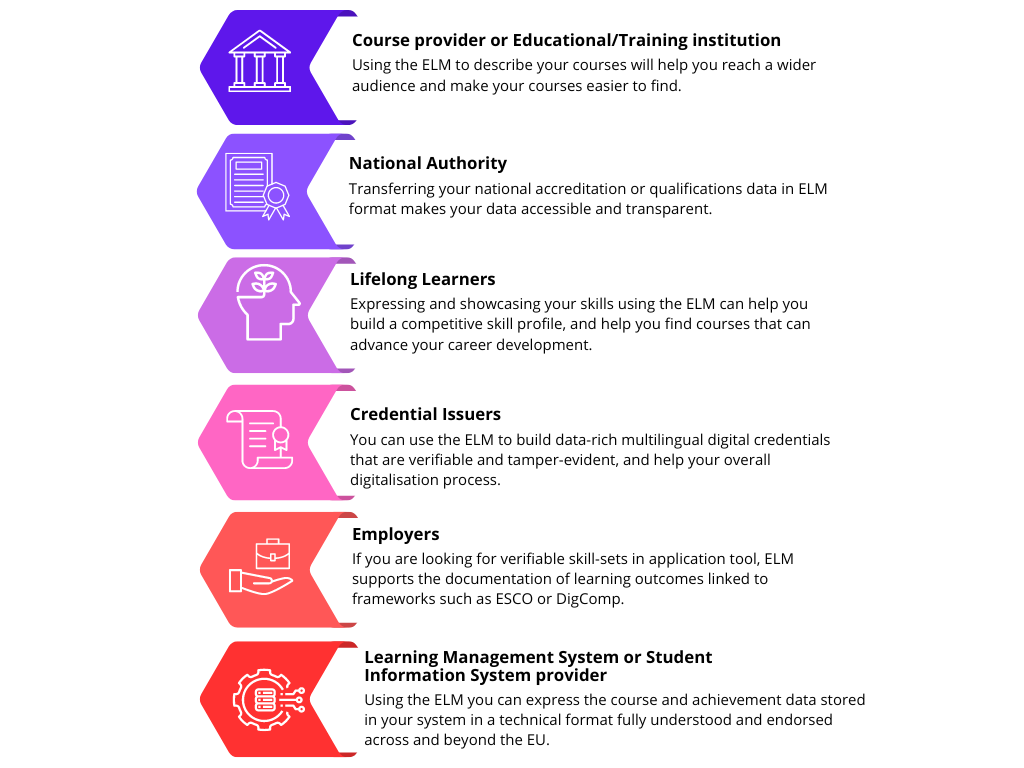Launch of the European Learning Model - A new step for Interoperability in Learning
The European Commission is launching the European Learning Model v.3 (ELM v.3). This first multilingual data model for learning is an exciting new development in the field of knowledge and skills data exchange, opening new possibilities for interoperability and credential exchange.
As part of the tasks set forward in the Europass Decision, the ELM will help further the goals of the European Skills Agenda, the European Education Area and the Digital Education Action Plan. Up until now, almost every sector, country, level of education and training, has had its unique way to provide data related to learning. This fragmentation has meant that software and IT systems have not been interoperable.
Built on open standards (W3C Verifiable Credential data model), the ELM provides the first unitary and comprehensive data model across the European Education Area, allowing for the building of truly trans-European systems. To support this task, the ELM is mapped to and interoperable with other models such as ELMO, the European Blockchain Services Infrastructure Diploma Use Case and the micro-credentials standards.
While previous versions of the data model were mainly aimed for the use of the European Commission and Member States, this new version of the data model is intended to serve as a foundational model for all learning data exchange in Europe.
By establishing a single vocabulary for learning in Europe, the ELM aims to help the recognition of qualifications and digital credentials across Europe. Aligning with the ELM allows for the comparability, transparency and portability of all data related to learning. The model has been extensively tested with pilots in most Member States to ensure that all concepts required by different countries, systems and types of learning are represented. The model provides users with the flexibility to document learning using over 480 properties, assuring support for multiple use cases.

Use cases for the ELM include the publication of qualification standards, creation of catalogues of learning opportunities, preparing curricula for courses, issuing digital credentials for learning, publishing data on accreditations of institutions, issuing recognition statements, issuing student identification cards and much more.
With ELM v.3, the European Commission is retiring disparate models that were used for Learning Opportunities, Credentials, Qualifications and Accreditations, as well as aligning with ELMO 1.8. While these models all had approximately the same classes and properties; they were not formally related, and changes to one model were rarely replicated in other models, leading to multiple inconsistencies. They are replaced with a new standardised ontology which is made available in different application profiles for each use case. Thus, any change to the ontology is automatically propagated throughout all applications.
The ontology is now made up of relations between concepts, meaning that we now know for instance that a learning outcome in a learning opportunity is the same concept as a learning outcome in a qualification. This allows for the creation of knowledge graphs to explain relationships between data, which will be extremely useful in enhancing and strengthening AI models. ELM can be used to power skills assessment tools, learning pathway suggestions, job recommendations and other kinds of automated guidance systems for European citizens. It is also an important step towards the construction of the Common European Skills Data Space.
Each concept is defined in the ELM namespace, allowing anyone building an application or data model to reuse its concepts. The ELM is also extensible, allowing any person to add their own concepts, or build new application profiles using the ontology for new use cases.
For further information about the ELM, we invite you to consult our Introduction to the ELM.
Benefits of ELM v3
- One stable, long-term support version of the model addressing all levels and forms of learning.
- The model is mapped to, and interoperable with, other models, including ELMO and the EBSI Diploma Use Case. It is also linked to existing frameworks and classifications (e.g. EQF, ESCO, ISCED-f).
- Built on open standards, in particular the W3C Verifiable Credential data model.
- Available in all 31 languages of Europass.
- Supports data exchange and credential recognition.
- Aligns with policy developments, EU initiatives and services (including standards on Micro-credentials and Annex VI of the EQF Council Recommendation).
- Allows learning providers to use the European Commission’s infrastructure to build and issue data-rich digital credentials completely free of charge.
- Allows for data on learning opportunities, qualifications, accreditation and credentials to be visualised, and interpreted in 31 languages, on the Europass portal.
You can access the ELM on Github and the Publication Office. For any questions regarding the ELM or its uses, you can get in touch with us at EMPL-ELM-SUPPORT@ec.europa.eu.
Watch the recording of our Launch Webinar

 Facebook
Facebook
 Twitter
Twitter
 Linkedin
Linkedin